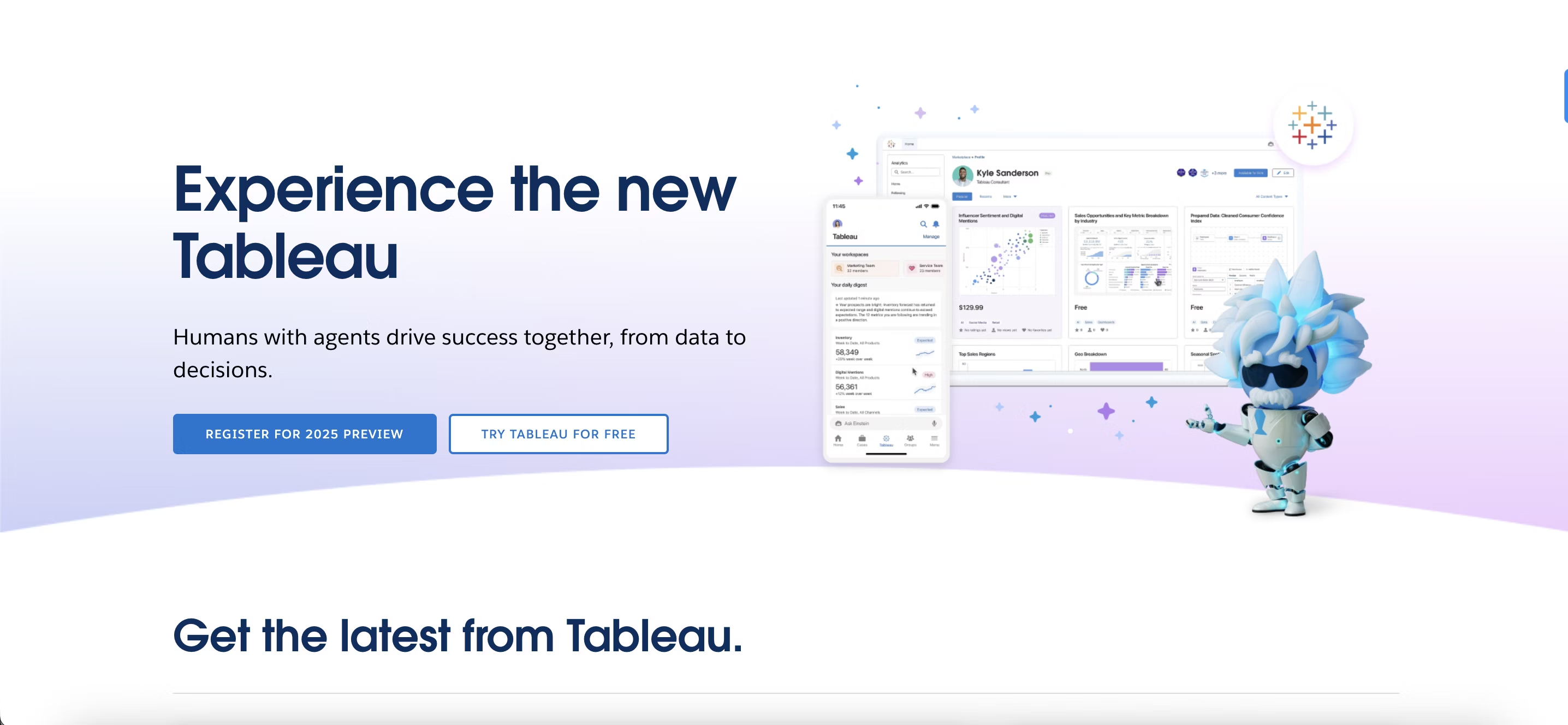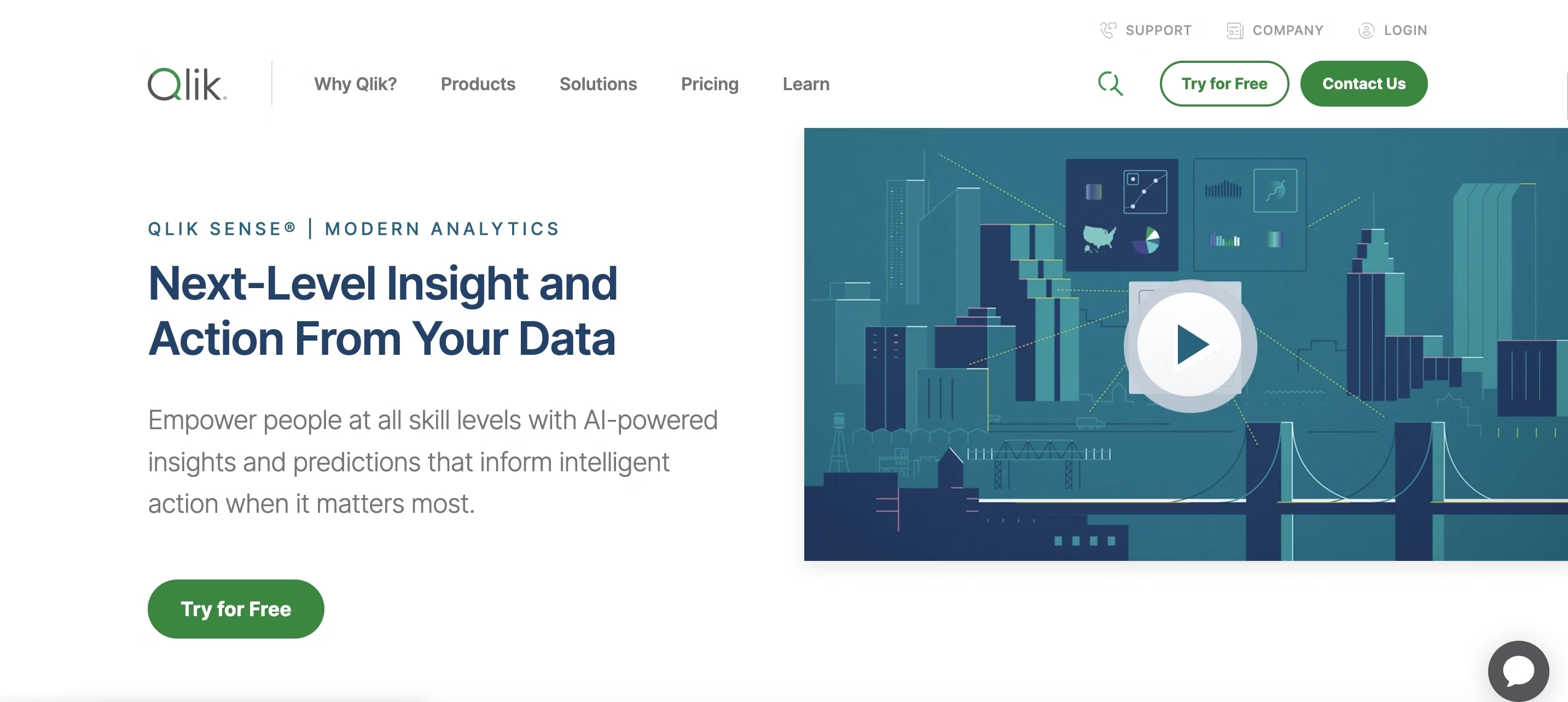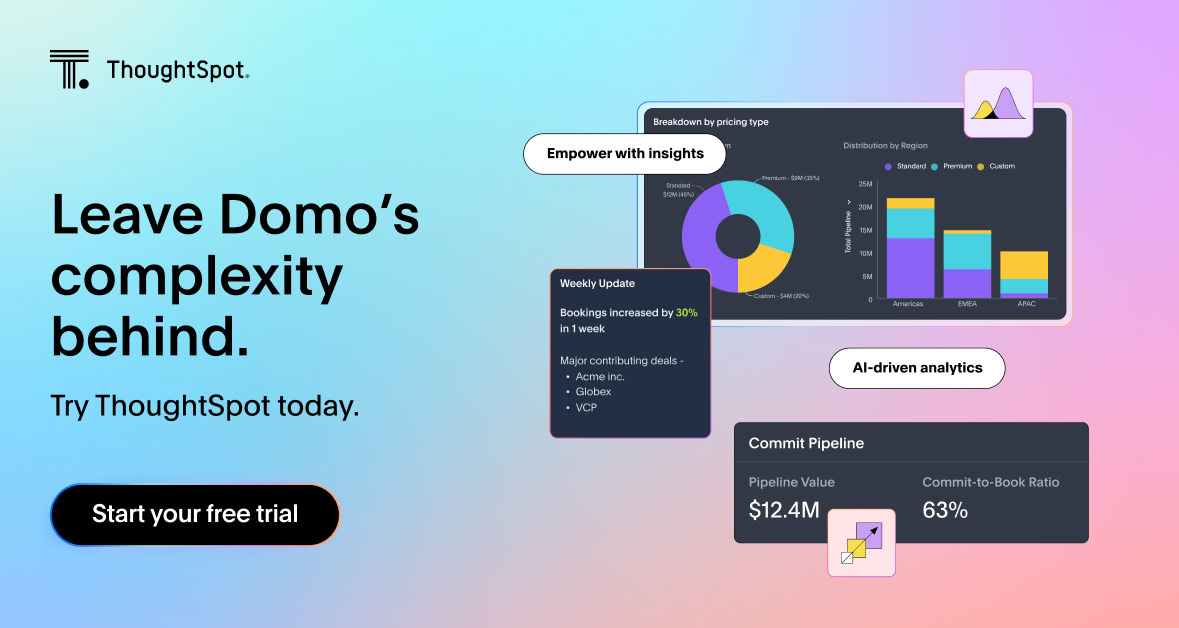Is Domo giving your team real answers—or just more dashboards?
At first glance, Domo looks like a solid BI tool, offering real-time dashboards, embedded analytics, and built-in collaboration. But once you start using it, those strengths come with trade-offs, especially when it comes to customization, pricing, and support.
If you’ve run into these issues, you’re not alone. Even as businesses continue to invest heavily in technology, 72% of organizations still struggle to manage their data effectively, according to McKinsey. The right analytics platform should simplify data management and make insights more accessible, not create more complexity.
If you’re here, chances are you’re rethinking whether Domo is the best fit for your organization. We’re here to help you find a platform that makes working with data easy—not frustrating. Let’s dive in.
What is Domo?
Domo is a cloud-based BI platform designed to connect data from multiple sources into interactive, real-time dashboards. It helps businesses visualize KPIs, embed analytics into workflows, and share data across teams.
For some teams, Domo is a great choice. But for others, it comes with trade-offs, especially around customization, cost, and scalability. If you need more flexibility or a tool that better aligns with your data strategy, it’s worth considering other options.
Where does Domo fall short?
Domo has plenty of strengths, but it also has some frustrating limitations that push users to look elsewhere. According to user reviews on platforms like G2, here are some common pain points:
Limited customization options: Domo makes it easy to build dashboards, but when it comes to tailoring them to fit your exact needs, options are limited.
Complex pricing structure: Domo’s subscription model isn’t the most budget-friendly, especially for businesses that need to scale. As you add more users or data sources, costs can rise quickly.
Steep learning curve: While Domo is designed to be user-friendly, many users say there’s a learning curve—especially for those without a technical background. With limited tutorials and support resources, getting up to speed can take longer than expected.
Slow customer support: Another commonly cited issue is the lag in customer support. Users have reported long wait times for technical assistance, which can hinder decision-making and delay critical business insights.
If any of these challenges sound familiar, it might be time for a change. After all, BI should be about insights, not obstacles. Let’s take a look at some alternatives that might be a better fit.
Quick summary
After evaluating top BI tools, we’ve rounded up the best Domo competitors and alternatives based on performance, customization, and ease of use.
- ThoughtSpot — Best for AI-powered search and self-service analytics
- Power BI — Good for integration with Microsoft tools and affordability
- Tableau — Good for advanced data visualization and dashboards
- Qlik Sense — Good for associative data modeling and intuitive interface
- Looker — Good for embedding analytics and comprehensive reporting
Top 5 Domo competitors and alternatives you should consider
ThoughtSpot is a leading analytics platform and a strong alternative to Domo, giving you AI-powered insights and real-time data exploration. With a G2 rating of 4.4, it stands out for its search-based interface and generative AI capabilities, letting you ask complex questions in natural language and get valuable insights without needing deep technical expertise.
Unlike Domo, which limits customization and has a steep learning curve, ThoughtSpot’s AI-driven search allows you to explore data freely without waiting on analysts or IT teams. Its intuitive, self-service interface eliminates bottlenecks, so you can access insights faster and make decisions with confidence.
To support a variety of analytics needs, ThoughtSpot offers two core products.
ThoughtSpot Analytics is a self-service platform that allows anyone to create and share personalized insights using natural-language search and AI.
ThoughtSpot Embedded provides a developer-friendly solution for integrating analytics experiences into any web application.
Key features of ThoughtSpot
Spotter, your AI Analyst: Get instant insights with AI-powered search. Just ask a question, dig deeper with follow-ups, and set real-time alerts—all without writing queries.
Intelligent dashboards: Say goodbye to outdated reports. ThoughtSpot’s AI-augmented dashboards update automatically, helping you track performance and find answers fast.
Advanced data modeling: Maintain full control over your data. ThoughtSpot connects with 20+ cloud platforms and offers ThoughtSpot Modeling Language (TML) for advanced governance, scripting, and automation.
Enterprise-wide connectivity: Integrate ThoughtSpot with cloud platforms and business apps for a unified analytics experience, eliminating data silos and improving accessibility.
AI-driven data prep: Automate data cleaning and preparation in Analyst Studio with AI-powered SQL, Python, and R tools so you can spend less time on grunt work and more on analysis.
We’ve covered the features, but how do they actually drive meaningful change? Northmill, a digital bank, harnessed ThoughtSpot’s AI-powered analytics to identify a segment of customers who weren’t completing the sign-up process. Armed with these insights from user data, Northmill refined its onboarding approach, leading to an impressive 30% increase in conversion rates.
Pros of ThoughtSpot
AI-powered search and natural language queries for effortless data exploration.
Self-service analytics that reduces reliance on data teams.
Easy integration with cloud data platforms for unified analytics.
Real-time updates to keep your decisions data-driven.
Cons of ThoughtSpot
Custom data modeling and other advanced features may require extra training to get the most value.
ThoughtSpot’s frequent updates bring new capabilities, which may take time to stay on top of.
Pricing
14-day free trial
Essentials: $1250 /month (20 users)
Pro: Custom
Enterprise: Custom
Microsoft’s Power BI is a well-known Domo alternative in the analytics space, offering a low-code interface that allows users to create visualizations effortlessly. While Domo and Power BI share similar capabilities, Power BI stands out for its easy integration with other Microsoft products.
Key features of Power BI
Data integration: Connect to sources like Excel, SQL Server, Azure, and third-party applications.
Customizable dashboards: Create interactive dashboards and reports with real-time data updates.
Data modeling: Use Power Query and Power Pivot to structure and manage complex data models.
Natural language queries: Ask questions about your data using everyday language with the Q&A feature.
Pros of Power BI
Works well with Microsoft tools, making it a strong choice for those already using the Microsoft ecosystem.
Offers a variety of visualization options for presenting data effectively.
Cons of Power BI
Customization for advanced visualizations can be more restrictive than in some other BI tools.
Performance may slow down with large datasets, requiring additional tools for processing.
Full functionality relies on cloud services, which may not be ideal for organizations with strict data privacy or compliance needs.
Pricing
Power BI Desktop - Free
Power BI Pro - $10/user/month
Power BI Premium per user - $20/user/month
Power BI Embedded - Variable

Acquired by Salesforce in August 2019, Tableau is one of the most popular data visualization tools on the market. Known for its robust features, this Domo competitor lets users create a wide range of visualizations, helping businesses turn raw data into actionable insights. Its intuitive interface and powerful analytics capabilities make it an option for both technical and non-technical users.
Key features of Tableau
Visualization: Build various chart types, including pie charts, bar charts, line charts, scatterplots, histograms, and treemaps.
Data blending: Combine multiple data sources in a single project to compare datasets and find insights.
Collaboration: Work on shared data projects through Tableau Server, Tableau Cloud, and Tableau Public.
Augmented analytics: Use AI and natural language queries to analyze data and generate contextual insights.
Pros of Tableau
Handles large datasets efficiently, processing millions of rows.
A strong online community provides access to resources, training, and forums.
Cons of Tableau
Limited parameter selection requires manual data updates.
Building complex datasets often requires SQL knowledge, though data can be explored once prepared.
Performance may slow down with large datasets, especially when working with complex visualizations.
Pricing
14-day free trial
Tableau Creator - $75.00/user/month
Tableau Explorer - $42.00/user/month
Tableau Viewer - $15.00/user/month
💡 See how ThoughtSpot compares to Tableau

Qlik Sense is a data analytics platform known for its self-service BI capabilities and intuitive user interface. It’s designed to help users analyze and visualize data freely, allowing businesses to make informed decisions without heavy reliance on IT. Its associative data model and advanced analytics features set it apart from other BI tools, though some users find its steep learning curve challenging—especially those without prior experience in data analytics.
Key features of Qlik Sense
Self-service visualization: Load and explore datasets with interactive, real-time visual updates.
Conversational search: Use search-based tools and natural language processing to find insights quickly.
Automated alerts: Receive notifications when data changes through automated workflows.
Embedded analytics: Integrate analytics into other applications using open APIs for customization.
Pros of Qlik Sense
Works across multiple devices, including desktops, laptops, tablets, and smartphones.
Allows users to create custom visualizations without requiring advanced technical expertise.
Cons of Qlik Sense
Performance may slow down when handling large datasets.
While cost-effective for small teams, per-user pricing can be expensive for larger organizations.
Exporting data to Excel can be problematic, with users reporting formatting issues like missing colors and fonts.
Pricing
30-day free trial
Qlik Sense Business - $30/user/month
Qlik Sense Enterprise SaaS - Variable

Looker is Google’s data exploration tool. The platform allows users to connect data from multiple sources, explore it using AI and ML technologies, and embed it on any product or website. Users can model their data using an SQL interface, build dashboards, and get a real-time view of critical KPIs, making it a powerful Domo competitor. Looker users can also leverage its semantic layer, LookerML, to perform ad-hoc queries and govern data.
Key features of Looker
Cloud-based: Use Looker’s cloud-based platform without downloads, simplifying deployment and enhancing security and permission management.
Data experiences: Build tailored data applications using reusable components and modules.
Advanced workflow development: Set up scheduled reports and alerts to monitor key business metrics proactively.
Extensive partner network: Connect with tools like Salesforce and Confluence to extend functionality beyond data visualization.
Pros of Looker
Lets users build custom reports and dashboards for deeper data insights.
Automates data processing tasks like aggregation and segmentation, improving efficiency.
User-friendly interface makes it accessible, even for those without technical expertise.
Cons of Looker
Sharing reports can be complex, making collaboration more difficult.
Connectivity issues can arise, especially with multiple visualizations.
Limited documentation makes learning the platform more challenging.
Pricing
30-day free trial
Looker's pricing structure is complex, with separate platform and user licensing costs. Platform pricing covers standard, enterprise, and embedded options, but lacks clarity on integration details and their costs.
User licensing offers three types—Developer, Standard, and Viewer—which complicates your choice. With fees ranging from $30 to $125 per user per month, costs can escalate quickly for larger organizations.
Redefine your approach to analytics with the right Domo alternative
Choosing the right analytics platform makes all the difference in how you use your data. While Domo can help with data visualization and management, many users find its customization options, pricing, and support limiting. That’s why you need a better alternative—one that’s easier to use, more flexible, and built for real-time insights.
ThoughtSpot gives you the freedom to explore data on your terms, with AI-powered search, deeper customization, and a user-friendly interface that anyone can navigate. Get faster answers, find new opportunities, and make smarter decisions with confidence.
See it in action—schedule a live demo!









